
Maria Feodorovna, known before her marriage as Princess Dagmar of Denmark, was Empress of Russia from 1881 to 1894 as the wife of Emperor Alexander III. She was the fourth child and second daughter of Christian IX of Denmark and Louise of Hesse-Kassel. Maria’s eldest son, Nicholas, was the last Emperor of Russia, ruling from 1 November 1894 until his abdication on 15 March 1917. Maria lived for 10 years after Bolshevik functionaries murdered Nicholas and his immediate family in 1918.
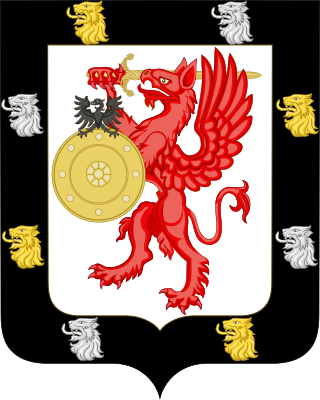
The House of Romanov was the reigning imperial house of Russia from 1613 to 1917. They achieved prominence after Anastasia Romanovna married Ivan the Terrible, the first crowned tsar of all Russia. Nicholas II and his immediate family were executed in 1918, but there are still living descendants.

Alexandra Feodorovna, Princess Alix of Hesse and by Rhine at birth, was the last Empress of Russia as the consort of Emperor Nicholas II from their marriage on 26 November [O.S. 14 November] 1894 until his forced abdication on 15 March [O.S. 2 March] 1917. A favourite granddaughter of Queen Victoria of the United Kingdom, she was, like her grandmother, one of the most famous royal carriers of haemophilia and bore a haemophiliac heir, Alexei Nikolaevich, Tsarevich of Russia. Her reputation for encouraging her husband's resistance to the surrender of autocratic authority and her known faith in the Russian mystic Grigori Rasputin severely damaged her popularity and that of the Romanov monarchy in its final years. She and her immediate family were all murdered while in Bolshevik captivity in 1918, during the Russian Revolution. In 2000, the Russian Orthodox Church canonized her as Saint Alexandra the Passion Bearer.

Grand Duchess Tatiana Nikolaevna of Russia was the second daughter of Tsar Nicholas II, the last monarch of Russia, and of Tsarina Alexandra. She was born at Peterhof Palace, near Saint Petersburg.

Grand Duchess Anastasia Nikolaevna of Russia was the youngest daughter of Tsar Nicholas II, the last sovereign of Imperial Russia, and his wife, Tsarina Alexandra Feodorovna.

Alexei Nikolaevich was the last Tsesarevich. He was the youngest child and only son of Emperor Nicholas II and Empress Alexandra Feodorovna. He was born with haemophilia, which his parents tried treating with the methods of a peasant faith healer named Grigori Rasputin.

The Alexander Palace is a former imperial residence near the town of Tsarskoye Selo in Russia, on a plateau about 30 miles (48 km) south of Saint Petersburg. The Palace was commissioned by Empress/Tsarina Catherine II in 1792.
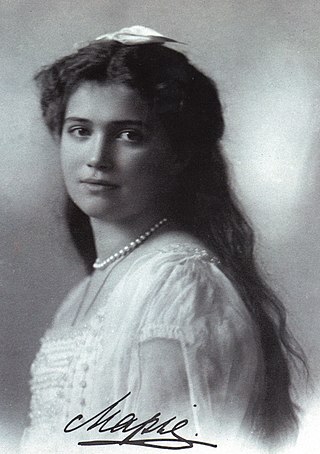
Grand Duchess Maria Nikolaevna of Russia was the third daughter of Tsar Nicholas II of Russia and Tsarina Alexandra Feodorovna. Her murder following the Russian Revolution of 1917 resulted in her canonization as a passion bearer by the Russian Orthodox Church.

In Eastern Christianity, a passion bearer is one of the various customary titles for saints used in commemoration at divine services when honouring their feast on the Church Calendar; it is not generally used by Catholics of the Roman Rite, but it is used within the Eastern Catholic Churches.

Princess Irene of Hesse and by Rhine, later Princess Henry of Prussia, was the third child and third daughter of Princess Alice of the United Kingdom and Louis IV, Grand Duke of Hesse and by Rhine. Her maternal grandparents were Queen Victoria and Prince Albert of Saxe-Coburg and Gotha. Her paternal grandparents were Prince Charles of Hesse and by Rhine and Princess Elisabeth of Prussia. She was the wife of Prince Henry of Prussia, a younger brother of Wilhelm II, German Emperor and her first cousin. The SS Prinzessin Irene, a liner of the North German Lloyd was named after her.

Grand Duchess Maria Nikolaevna of Russia was a daughter of Emperor Nicholas I of Russia, and sister of Alexander II. In 1839 she married Maximilian, Duke of Leuchtenberg. She was an art collector and President of the Imperial Academy of Arts in Saint Petersburg.
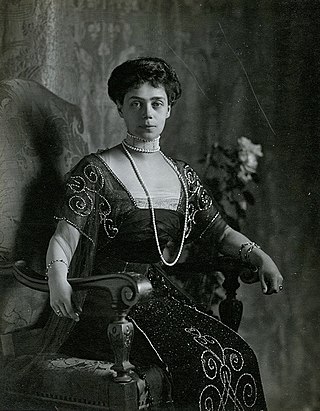
Grand Duchess Xenia Alexandrovna of Russia was the elder daughter and fourth child of Tsar Alexander III of Russia and Empress Maria Feodorovna of Russia and the sister of Emperor Nicholas II.

Sophie Freiin von Buxhoeveden, also known as Baroness Sophie Buxdoeveden, was a Baltic German Lady-in-waiting, in service to Tsarina Alexandra of Russia. She was the author of three memoirs about the imperial family and about her own escape from Russia.
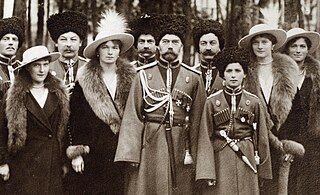
Members of the ruling Russian imperial family, the House of Romanov, were executed by a firing squad led by Yakov Yurovsky in Yekaterinburg, Russia, on July 17, 1918, during both the Russian Civil War and near the end of the First World War.

Anastasia: The Mystery of Anna is a 1986 American-Austrian-Italian made-for-television biographical film directed by Marvin J. Chomsky, starring Amy Irving, Rex Harrison, Olivia de Havilland, Omar Sharif, Christian Bale and Jan Niklas. The film was loosely based on the story of Grand Duchess Anastasia Nikolaevna of Russia and the book The Riddle of Anna Anderson by Peter Kurth. It was originally broadcast in two parts.

The Romanovs: An Imperial Family is a 2000 Russian historical drama film about the last days of Tsar Nicholas II and his family. The Russian title implies both the Imperial Crown of Russia and the crown of thorns associated with martyrs. The film premiered at the 22nd annual Moscow Film Festival. The film was selected as the Russian entry for the Best Foreign Language Film at the 76th Academy Awards, but it didn't make the final shortlist.
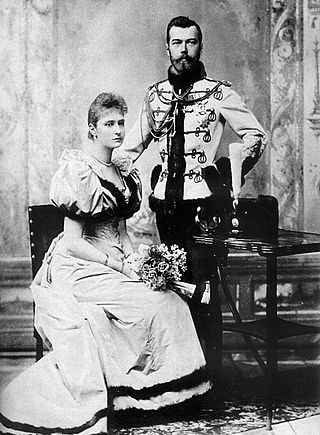
The wedding of Nicholas II of Russia to Alexandra Feodorovna occurred on 26 November [O.S. 14 November] 1894 at the Grand Church of the Winter Palace.

Grand Duchess Olga Nikolaevna of Russia was the eldest child of the last Tsar of the Russian Empire, Emperor Nicholas II, and of Empress Alexandra of Russia.

Alexandra Alexandrovna Tegleva, also known as Shura Tegleva and Sasha Tegleva, was a Russian noblewoman who served as a nursemaid in the Russian Imperial Household. As nursemaid to the children of Emperor Nicholas II and Empress Alexandra Feodorovna, she went with the family into exile in Tobolsk following the abdication of Nicholas II during the February Revolution, but was ultimately prevented from staying with them during their house arrest at Ipatiev House. She survived the Russian Revolution and married Pierre Gilliard, a Swiss academic who served with her in the Imperial Household as the children's French tutor. She moved to Lausanne as a white émigré and remained there the rest of her life. Tegleva worked with her husband to investigate and debunk the claims made by Anna Anderson, a Romanov impostor who pretended to be Grand Duchess Anastasia Nikolaevna.
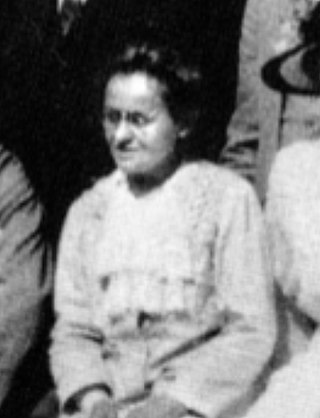
Elizaveta Nikolaevna "Liza" Ersberg was a German-Russian parlormaid who served in the Russian Imperial Household. The daughter of a stoker employed by Emperor Alexander III, she was hired by Empress Maria Feodorovna as a parlormaid at the Alexander Palace in 1898. She used her post to obtain a position at court for her friend Anna Demidova, who became a lady-in-waiting to Empress Alexandra Feodorovna.




















